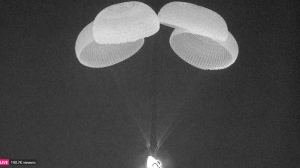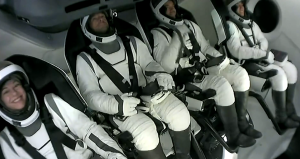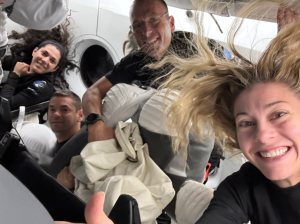Polaris Dawn Splashes Down After Five Busy Days
The Polaris Dawn private astronaut mission came to an end this morning, splashing down in the Dry Tortugas near Key West, Florida. The five-day flight achieved a number of firsts including flying higher than any previous earth-orbiting human spaceflight mission and the first commercial spacewalk. It was also the first Dragon landing in the Dry Tortugas, a new SpaceX splashdown site.
Jared Isaacman, Scott “Kidd” Poteet, Sarah Gillis and Anna Menon waited more than two weeks for liftoff on September 10 from the Kennedy Space Center because of weather. Unlike most other Crew Dragon flights, Polaris Dawn did not visit the International Space Station so could only remain in space as long as air and other supplies lasted. That meant they had to know before launch that the landing weather also would be favorable.
Indeed it was this morning at 3:37 am ET and splashdown went perfectly.




During their five days in orbit, they reached an altitude of 1,400.7 kilometers (870 miles) according to a post from SpaceX on X, although a commentator on SpaceX’s landing broadcast said it was 1,408 km. Either way it is higher than the 1,373 km (853 miles) record set by Gemini 11 in 1966. The only human spaceflight missions that have gone further were the Apollo missions to the Moon (Apollo 8, 10, 11, 12, 13, 14, 15, 16 and 17) between 1968 and 1972.
Achievement unlocked – apogee 1,400.7 km
Forward bulkhead Draco firing during burn ???? pic.twitter.com/Z7kUTcA2CH
— SpaceX (@SpaceX) September 11, 2024
They lowered their altitude to about 700 km (430 miles) to conduct the world’s first commercial spacewalk. Isaacman and Gillis spent about 8 minutes each standing in a frame attached to Crew Dragon’s hatch called Skywalker, testing the SpaceX-designed spacesuits. Crew Dragon does not have an airlock so the entire capsule had to be depressurized and all four crew members were in spacesuits even though only two of them actually exited the spacecraft.
Commander @rookisaacman has egressed Dragon and is going through the first of three suit mobility tests that will test overall hand body control, vertical movement with Skywalker, and foot restraint pic.twitter.com/XATJQhLuIZ
— SpaceX (@SpaceX) September 12, 2024
They also conducted about 40 scientific experiments and tested communications through SpaceX’s Starlink satellite broadband Internet system.
Join the Polaris Dawn crew to learn details behind some of the ~40 science and research experiments being conducted during the mission. Many of these experiments will provide valuable data regarding human health in space ahead of future long-duration space missions pic.twitter.com/yw89eGf11U
— Polaris (@PolarisProgram) September 13, 2024
Early this morning via @Starlink space lasers, the Polaris Dawn crew chatted with SpaceX teams over coffee and donuts ????????️ pic.twitter.com/nZ9v0VSyr5
— SpaceX (@SpaceX) September 14, 2024
Isaacman is a billionaire tech entrepreneur and experienced private fighter jet pilot who paid for this mission and Inspiration4 in 2021. He’s purchased another Crew Dragon mission and the first crewed earth-orbital flight of SpaceX’s Starship, which is still in development. The dates for those flights have not been announced. Poteet is a retired Air Force pilot who works for one of Isaacman’s companies. Menon and Gillis are SpaceX engineers who worked with Isaacman on the Inspiration4 mission.

Isaacman and his crewmates use these missions as fundraising opportunities for St. Jude Children’s Research Hospital. Menon co-authored a children’s book, Kisses from Space, that she read to her own two children and children at St. Jude’s during the mission. Proceeds from sales of the book will go to St. Jude’s.
Proceeds from the book will go to @StJude → https://t.co/pOPX8IVsRR https://t.co/lEgkjkUaYz
— SpaceX (@SpaceX) September 12, 2024
Gillis is a classical violinist and played John Williams’ Rey’s Theme from Star Wars with an orchestra and children from several countries around the world. Their Crew Dragon is named Resilience and the compelling performance is called Harmony of Resilience.
Brought to you from the stars ????????️❤️ https://t.co/nhcrOBscDk
— Starlink (@Starlink) September 13, 2024
User Comments
SpacePolicyOnline.com has the right (but not the obligation) to monitor the comments and to remove any materials it deems inappropriate. We do not post comments that include links to other websites since we have no control over that content nor can we verify the security of such links.